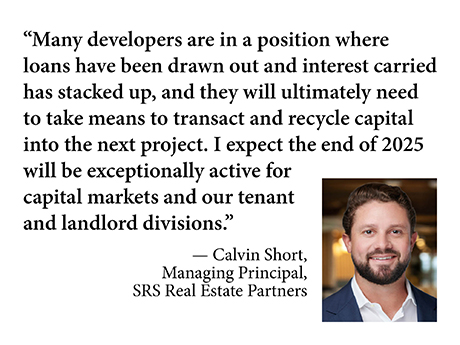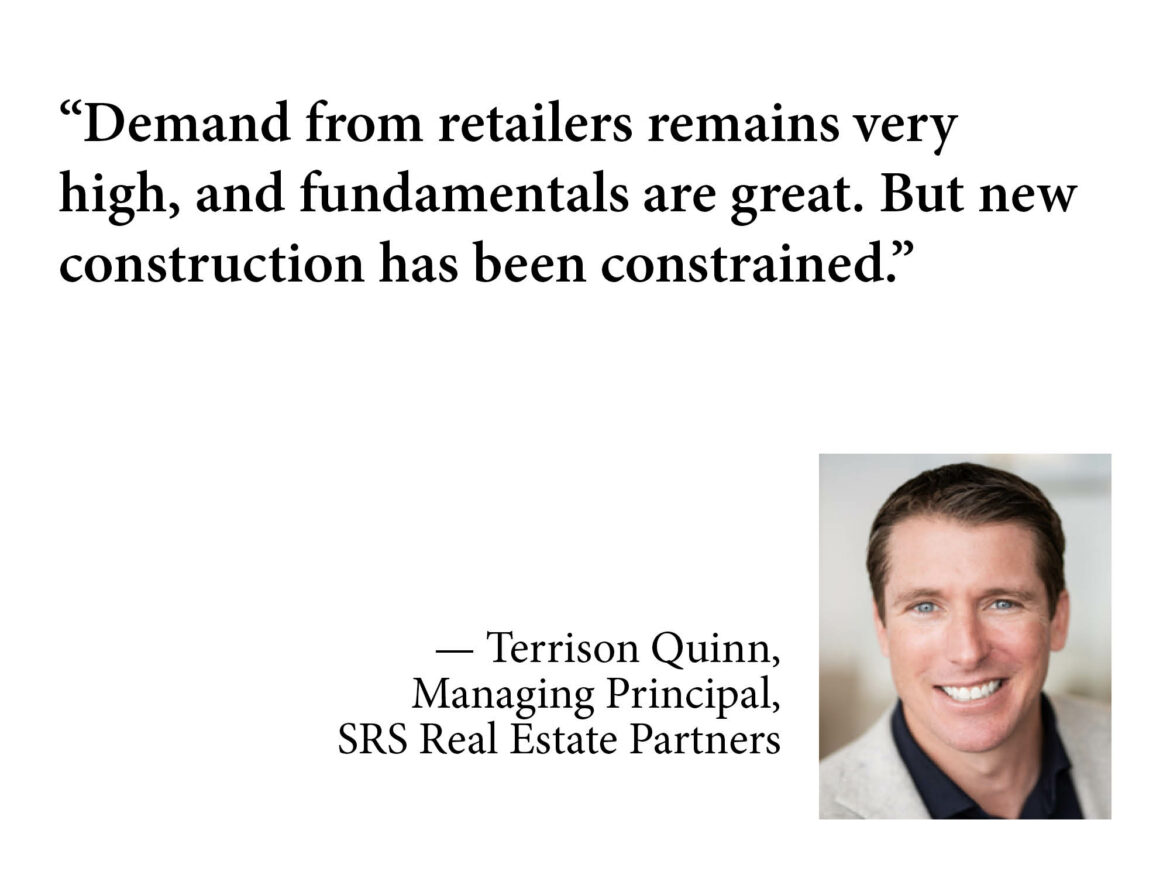If Calvin Short and Terrison Quinn, managing principals at SRS Real Estate Partners, could sum up the Southern California (SoCal) retail investment sales and leasing environment with one word, it would be “undersupplied.”
From an investment standpoint, the region lacks depth in available properties for sale, unlike other parts of the country where there have been leverage shifts in favor of the buyer due to oversupply, says Short, who represents buyers and sellers of retail assets nationwide. That’s particularly true in the net-lease space, which is driving some SoCal-based investors to seek quality assets with good lease economics and real estate fundamentals in comparable high-growth markets. Markets like Arizona, Nevada, Colorado, Texas, Florida, Tennessee, Georgia and the Carolinas are seeing considerable increases in deal velocity.
SRS Real Estate will explore these topics and more at the upcoming ICSC Western conference, September 29-30. Visit them at booth 505 in the Palm Springs Convention Center.
New retail development could add more for-sale inventory; but, in addition to a high cost of capital, construction barriers include an entitlement process that can take over a year to complete. It feels like the time associated with entitling projects and various uses is about double the amount of time it took several years ago, say Short and Quinn, who are based in Newport Beach.
The dynamic is affecting the leasing market as well. Despite an uptick in vacancy in some submarkets, retail expansion opportunities are limited, notes Quinn, who represents developers and landlords. “I keep using the word ‘grindy’ to describe the market, as in it has been a slow grind to get deals done and new businesses open for business,” he reports.
“Demand from retailers remains very high, and fundamentals are great. But new construction has been constrained.”
Closed Stores and Demand
The situation is most evident in Orange County, where the average vacancy rate is around 4 percent and dropping, he says. Some 307,000 square feet are under construction in the market, down roughly 12 percent from its 10-year average, according to SRS Real Estate. In the Inland Empire, the average vacancy rate of 6.8 percent and construction are both on par with historic norms. Developers are building about 1.2 million square feet of primarily grocery-anchored centers.
The outlier is Los Angeles County, where the average vacancy rate typically mirrors Orange County. But today it’s just north of 6 percent and rising, Quinn observes. A number of new deliveries in 2023 contributed to the vacancy, but only 600,000 square feet of retail space are currently under construction, well below the 10-year average of 1.4 million square feet.
Another and arguably larger culprit fueling vacancy is store closings as a consequence of bankruptcies. Big Lots, Party City and 99 Cents Only Stores declared bankruptcy in 2023 and 2024, and Rite Aid followed suit last spring. Meanwhile, Walgreens and others are shuttering locations to cut costs.
On the bright side, the closings are bringing space to the market. Many bigger boxes that emptied during the earlier round of bankruptcies have already been filled by fitness users such as Planet Fitness, grocers like ALDI and Grocery Outlet, and hardware stores and discounters, Quinn says. More recently, drive-thru restaurants, fuel and charging stations and car washes have begun eyeing stand-alone Rite Aid and Walgreens ground-lease locations with the intent to raze the structures and construct their own buildings. Family entertainment operators, light fitness users and discount soft goods retailers are among the tenants interested in inline shopping center locations, he adds.
“The Rite Aid bankruptcy and Walgreens rightsizing will continue to push vacancy up as more of those assets hit the market,” Quinn remarks. “But the demand for the buildings is significant.”

Necessity Demand
Institutional, family office and high-net-worth investors continue to dominate the landscape in SoCal, with a tendency to focus on necessity-based retail assets like grocery-anchored centers in higher-income coastal markets, Short says. Those with less access to capital or executing 1031 exchanges in the $2 to $10 million range are typically targeting unanchored multi-tenant properties with a mix of national and regional credit. Also targeted are free-standing single-tenant net-lease assets with brands that have reusable footprints and flexibility on layout, drive-thru stacking and dedicated pick up lines for third-party services like Uber Eats, DoorDash and Postmates, he adds.
“Often when I’m contacted by investors with upcoming 1031 exchanges to fulfill, our conversations center around the availability of free-standing restaurants with a drive-thru component, given the attention major brands like Chick-fil-A, Raising Cane’s, Chipotle, McDonald’s and Dutch Bros Coffee have given to stacking and drive-thru efficiency to increase the flow of customer traffic,” says Short.
“These assets were getting the most attention when I got into the business 12 years ago, and the same can still be said today. The challenge is that scarcity and an overarching increase in construction costs reflect back on the investor via increases in the average price for a high-quality quick-service restaurant in SoCal. “
In addition to a lack of availability of quality assets, a reduction in 1031 exchange activity as a result of sluggish multifamily sales is hampering investment transactions. A huge driver for net-leased capital markets is legacy multifamily owners divesting of properties in exchange for passive retail investments as a means of generating higher cash flows or softening management burdens, Short explains.
Although the market has seen a drastic pullback in multifamily velocity over the past 24 months in SoCal, Short is optimistic that the Federal Reserve’s recent rate cut could help convince multifamily and net-lease owners who have been waiting for a better sales environment to move off the sidelines.
“Many developers are in a position where loans have been drawn out and interest carried has stacked up, and they will ultimately need to take means to transact and recycle capital into the next project,” Short states. “So, I expect the end of 2025 will be exceptionally active for capital markets and our tenant and landlord divisions.”
— By Joe Gose. This article was written in conjunction with SRS Real Estate Partners, a content partner of Shopping Center Business.


